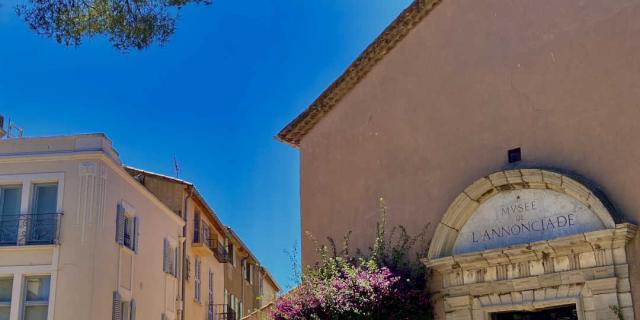Places visited
Saint-Tropez
Le Cannet
Cagnes-sur-Mer
Nice
 Claude Monet Villas Bordighera Musee Dorsay Dist. Rmn Grand Palais Pschmidt
Claude Monet Villas Bordighera Musee Dorsay Dist. Rmn Grand Palais PschmidtMeeting the Impressionists on the Côte d’Azur
April 15th, 1874. A group of young artists staged the very first Impressionist art exhibition at 35 Boulevard des Capucines in Paris, in the former studio of the photographer Nadar. Their names? Berthe Morisot, Edgar Degas, Claude Monet and Auguste Renoir. The Impressionist movement actually emerged in France a few years prior, characterized by its swift lines, blurred effects and particular attention to capturing the light. The movement inherently opposed the codes of academic art: Claude Monet’s Luncheon on the Grass is one of its flagship works. Initially misunderstood, Impressionism whipped up a storm well before it ever entered a museum. Today, however, the Musée d’Orsay in Paris harbours the world’s largest collection of Impressionist works. This year, in celebration of the 150th anniversary of a movement that forever marked the history of art, the Musée d’Orsay is fronting the exhibition Paris, 1874. Inventing Impressionism, from March 26th to July 14th, 2024. At the same time, 178 works will be exhibited at museums all over France including Provence, where Impressionist paintings are already on show at many museums.
 Claude Monet Dejeuner Sur Lherbe Exclu Museedorsay Dist. Rmn Grand Palais Pschmidt
Claude Monet Dejeuner Sur Lherbe Exclu Museedorsay Dist. Rmn Grand Palais PschmidtSaint-Tropez was still just a little fishing village when Paul Signac anchored his yacht, the Olympia, there in 1892. The Paris-born painter was immediately captivated by the village’s scenery and intense light and colours. He settled down in Saint-Tropez, where his oeuvre evolved significantly. The colours multiplied and became more vivid. Shouldered by his friend Georges Seurat, Paul Signac birthed the Pointillist movement – a painting technique largely influenced by the Impressionists, characterized by the use of little, juxtaposed touches of pure, unmixed paint. Set inside a 16th century chapel, the Musée de l’Annonciade in Saint-Tropez tells the story of this colourful movement that so wonderfully conveys the warmth of the South of France. In addition to canvasses by Signac and Seurat, the museum shows works by the libertarian Maximilien Luce, as well as Henri-Edmond Cross – also seduced by Provence -, Théo Van Rysselberghe and Jeanne Selmersheim-Desgrange.
Also close to the Impressionists, but a resolutely free spirit, Pierre Bonnard shared the movement’s blurring technique and passion for the region’s natural landscapes and quality of light. In 1926, he purchased a house named Le Bosquet on the heights of Le Cannet, in the Alpes-Maritimes. Today, the Musée Bonnard is paying tribute to him in this town between sea and mountains, where Bonnard produced over 300 works including views of Le Cannet, scenes from Le Bosquet and works influenced by Japanese art. In 2024, the museum will be welcoming two canvasses by Henri de Toulouse-Lautrec: The Clowness (1895) and The Woman with Gloves (1890), as part of the Toulouse-Lautrec tête d’affiche exhibition, bringing together Toulouse-Lautrec’s lithographic works and demonstrating that Bonnard’s posters were fundamental to his creative process. In fact, it was Bonnard’s first poster, France-Champagne, that drove Lautrec to try his hand at an art form he was later to master to perfection.
Musée Bonnard – Le Cannet – March 16th to June 9th, 2024
 Toulouse Lautrec Clownesse Exclu Musee Dorsay Dist. Rmn Grand Palais Pschmidt
Toulouse Lautrec Clownesse Exclu Musee Dorsay Dist. Rmn Grand Palais PschmidtOne of the very first Impressionists – he took part in the first exhibition in 1874 – Auguste Renoir was passionate about painting scenes from everyday life in Paris. Unlike most painters in the movement, including his close friend Claude Monet, he chose to paint portraits and female nudes rather than landscapes. He visited the South of France regularly in the 1880s, before purchasing Domaine des Collettes in Cagnes-sur-Mer in 1908. This magnificent property filled with flowers, olives and citrus fruit, gazing out over Cap d’Antibes, became his main source of inspiration until his death in 1919. Now renamed the Musée Renoir, Domaine des Collettes offers a moving immersion in the painter’s universe with 14 paintings and 40 sculptures, together with his studio, furniture and private archives.
Born in northern France, Henri Matisse was captivated by the clarity of the daylight when he moved to Nice in 1917. “When I realized that I would see this light again every morning, I could not believe my luck,” he wrote. Around twenty years earlier, Matisse had experimented with the Pointillist painting style in Saint-Tropez, alongside Paul Signac and Henri-Edmond Cross. He went on to spearhead the Fauvist movement, an heir to Impressionism that nevertheless advocates a more subjective use of colour. The Musée Matisse in Nice harbours a vast collection testifying to these various influences, including Storm in Nice (1919-1920) and Still Life with Pomegranates (1947). Berthe Morisot, the movement’s first female member, is also in the limelight in Nice for the 150th anniversary celebrations. Morisot lived in Paris but sojourned on the Riviera in 1881-1882 and 1888-1889, at a time when Nice was a buzzing artistic hub. The Berthe Morisot à Nice, escales impressionnistes exhibition offers a deep dive into the artist’s two Riviera stays through specialist eyes. It unveils the unique nature of the works from her Nice period versus those of Renoir or Monet, who were also regular visitors to the Mediterranean at the time. Her paintings rub shoulders with those of Monet (including Villas in Bordighera, 1884) and Renoir, together with other women close to the Impressionist movement (Eva Gonzalès, Mary Cassatt, Louise Breslau, Marie Bashkirtseff, etc.).
Musée des Beaux-Arts Jules Chéret – Nice – April 5th to September 29th, 2024










